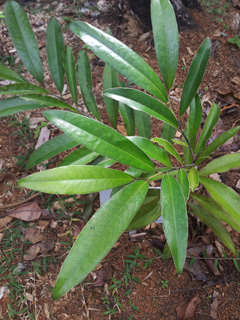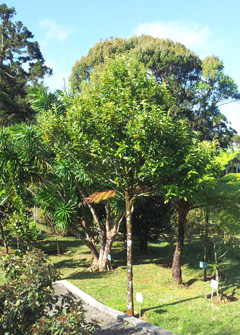 |
|
https://edibleplants.org/ |
 |
| https://edibleplants.org/ |
Translate this page:
Summary
Diospyros tessellaria or commonly known as Mauritian Ebony or Black Ebony is an evergreen shrub or small tree about 20 m in height that can be found in Africa. Its leaves are thick and dark green in colour. Flowers and fruits are small. Its bark and heartwood are black while its sapwood is white. It produces a high quality timber used for musical instruments, small pieces of furniture and in marquetry.
Physical Characteristics

 Diospyros tessellaria is an evergreen Tree growing to 15 m (49ft) by 15 m (49ft) at a slow rate.
Diospyros tessellaria is an evergreen Tree growing to 15 m (49ft) by 15 m (49ft) at a slow rate.
See above for USDA hardiness. It is hardy to UK zone 10. The flowers are pollinated by Bats.
It is noted for attracting wildlife.
Suitable for: light (sandy), medium (loamy) and heavy (clay) soils and prefers well-drained soil. Suitable pH: mildly acid, neutral and basic (mildly alkaline) soils. It cannot grow in the shade. It prefers moist soil.
UK Hardiness Map
US Hardiness Map
Synonyms
Diospyros reticulata Willd. [Illegitimate]
Plant Habitats
Edible Uses
Edible Parts: Fruit
Edible Uses:
Fruit[ 511 ].
References More on Edible Uses
Medicinal Uses
Plants For A Future can not take any responsibility for any adverse effects from the use of plants. Always seek advice from a professional before using a plant medicinally.
None known
References More on Medicinal Uses
The Bookshop: Edible Plant Books
Our Latest books on Perennial Plants For Food Forests and Permaculture Gardens in paperback or digital formats.

Edible Tropical Plants
Food Forest Plants for Hotter Conditions: 250+ Plants For Tropical Food Forests & Permaculture Gardens.
More

Edible Temperate Plants
Plants for Your Food Forest: 500 Plants for Temperate Food Forests & Permaculture Gardens.
More

More Books
PFAF have eight books available in paperback and digital formats. Browse the shop for more information.
Shop Now
Other Uses
Furniture Wood
Other Uses: A high quality timber, known as 'Mauritius Ebony' is obtained from the tree[ 46 ]. The bark is black, the sapwood is white and the heartwood black. The wood is used to manufacture keys of musical instruments, small pieces of furniture and in marquetry.
Special Uses
Attracts Wildlife
References More on Other Uses
Cultivation details
Tolerates both dry lowland areas and upland wet rainforest. Now rarely coastal. A canopy tree that was exploited on a large scale during the Dutch occupation of Mauritius in the 17th century. You may have to wait 50 years to harvest the black infamous heartwood. Prefers temperatures no less than 54 F. In general Diospyros species are dioecious and require both male and female forms to be grown if fruit and seed are required[ 899 ].
References Carbon Farming Information and Carbon Sequestration Information
Temperature Converter
Type a value in the Celsius field to convert the value to Fahrenheit:
Fahrenheit:
The PFAF Bookshop
Plants For A Future have a number of books available in paperback and digital form. Book titles include Edible Plants, Edible Perennials, Edible Trees,Edible Shrubs, Woodland Gardening, and Temperate Food Forest Plants. Our new book is Food Forest Plants For Hotter Conditions (Tropical and Sub-Tropical).
Shop Now
Plant Propagation
Seed - it has a very short viability and so should be sown as soon as possible[ 325 ]. The flesh should be removed since this contains germination inhibitors[ 325 ]. Sow the seed in a shady position in a nursery seedbed. The sowing media for ebony uses soil and fine sand at the ratio 3:1. The seed is planted horizontally or vertically with the radicle end down, with a sowing depth of 1 - 1.5x the thickness of seed. Distance between the seeds is 3 - 5cm. Seeds are very sensitive to desiccation during germination and early growth, so must be regularly watered at this time[ 325 ]. Normally the seed will germinate after one week. In one trial, fresh seed, sown one day after collection, showed 85% germination rate within 17 - 65 days[ 325 ]. As a rule fresh seeds have a high percentage of fertility. The seedlings develop long taproots at an early stage, often before any appreciable elongation of the shoot takes place. The growth of the seedling is decidedly slow [ 652 ].
Other Names
If available other names are mentioned here
Native Range
AFRICA: Mauritius
Weed Potential
Right plant wrong place. We are currently updating this section.
Please note that a plant may be invasive in one area but may not in your area so it's worth checking.
Conservation Status
IUCN Red List of Threatened Plants Status : Status: Vulnerable B1+2cde

| Related Plants
|
| Latin Name | Common Name | Habit | Height | Hardiness | Growth | Soil | Shade | Moisture | Edible | Medicinal | Other |
| Diospyros celebica | Indonesian Ebony, black ebony, makassar-ebenholts | Tree | 30.0 |
10-12
| S | LMH | N | M | 2 | 0 | 4 |
| Diospyros conzattii | Zapote negro mont's, zapotillo. | Tree | 10.0 |
10-12
| S | LMH | N | DM | 4 | 0 | 2 |
| Diospyros crassiflora | Benin Ebony | Tree | 15.0 |
10-12
| S | LMH | N | M | 0 | 2 | 4 |
| Diospyros digyna | Black Sapote, Chocolate Pudding Tree | Tree | 15.0 |
10-12
| S | LMH | SN | M | 4 | 1 | 2 |
| Diospyros ebenum | Ebony, Ceylon Ebony, Mauritius Ebony, Ebony Persimmon | Tree | 20.0 |
10-12
| S | LMH | N | M | 1 | 2 | 4 |
| Diospyros kaki | Persimmon, Japanese persimmon | Tree | 12.0 |
7-10
| M | LMH | SN | M | 4 | 3 | 3 |
| Diospyros lotus | Date Plum | Tree | 9.0 |
7-9
| M | LMH | SN | M | 5 | 1 | 3 |
| Diospyros malabarica | Indian Persimmon, Gaub, Timbiri, Mountain ebony | Tree | 35.0 |
10-12
| S | LMH | FSN | M | 1 | 3 | 4 |
| Diospyros mespiliformis | West African Ebony, Monkey guava, jackalberry | Tree | 20.0 |
10-12
| M | LMH | N | M | 4 | 3 | 4 |
| Diospyros mun | Mun Ebony, Vietnamese Ebony | Tree | 15.0 |
10-12
| S | LMH | N | DM | 0 | 0 | 4 |
| Diospyros quaesita | Calamander, kalu mediriya | Tree | 30.0 |
10-12
| S | LMH | N | DM | 0 | 2 | 4 |
| Diospyros texanum | Black Persimmon | Tree | 12.0 |
-
| | LMH | SN | M | 2 | 0 | 3 |
| Diospyros virginiana | American Persimmon, Common persimmon, Persimmon | Tree | 20.0 |
4-8
| M | LMH | SN | M | 5 | 1 | 3 |
|
Growth: S = slow M = medium F = fast. Soil: L = light (sandy) M = medium H = heavy (clay). pH: A = acid N = neutral B = basic (alkaline). Shade: F = full shade S = semi-shade N = no shade. Moisture: D = dry M = Moist We = wet Wa = water.
Now available:
Food Forest Plants for Mediterranean Conditions
350+ Perennial Plants For Mediterranean and Drier Food Forests and Permaculture Gardens.
[Paperback and eBook]
This is the third in Plants For A Future's series of plant guides for food forests tailored to
specific climate zones. Following volumes on temperate and tropical ecosystems, this book focuses
on species suited to Mediterranean conditions—regions with hot, dry summers and cool, wet winters,
often facing the added challenge of climate change.
Read More
Expert comment
Author
Poir.
Botanical References
Links / References
For a list of references used on this page please go here
A special thanks to Ken Fern for some of the information used on this page.
Readers comment
| Add a comment |
|
If you have important information about this plant that may help other users please add a comment or link below. Only comments or links that are felt to be directly relevant to a plant will be included. If you think a comment/link or information contained on this page is inaccurate or misleading we would welcome your feedback at [email protected]. If you have questions about a plant please use the Forum on this website as we do not have the resources to answer questions ourselves.
* Please note: the comments by website users are not necessarily those held by PFAF and may give misleading or inaccurate information.
To leave a comment please Register or login here All comments need to be approved so will not appear immediately.
|
Subject : Diospyros tessellaria
|
|
|
|